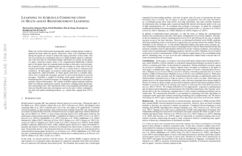How the nonlinear coupled oscillators modelization explains the Blazhko effect, the synchronisation of layers, the mode selection, the limit cycle, and the red limit of the instability strip
Context. The Blazhko effect, in RR Lyrae type stars, is a century old mystery. Dozens of theory exists, but none have been able to entirely reproduce the observational facts associated to this modulation phenomenon. Existing theory all rely on the usual continuous modelization of the star. Aims. We present a new paradigm which will not only explain the Blazhko effect, but at the same time, will give us alternative explanations to the red limit of the instability strip, the synchronization of layers, the mode selection and the existence of a limit cycle for radially pulsating stars. Methods. We describe the RR Lyrae type pulsating stars as a system of coupled nonlinear oscillators. Considering a spatial discretisation of the star, supposing a spherical symmetry, we develop the equation of motion and energy up to the third order in the radial and adiabatic case. Then, we include the influence of the ionization region as a relaxation oscillator by including elements from synchronisation theory. Results. This discrete approach allows us to exploit existing results in the coupled nonlinear oscillator field. For instance, the study of synchronicity leads to an explanation of the mode selection, the layers synchronisation, the limit cycle and the red limit of the instability strip. But, most of all, the analogy with the Fermi-Pasta-Ulam (FPU) experiment enables us to understand the Blazhko effect. The transfer of energy between different modes, as induced by solitons, not only gives a plausible theory for lightcurve modulation, but also explains the asymmetry of sidelobes.
PDF Abstract